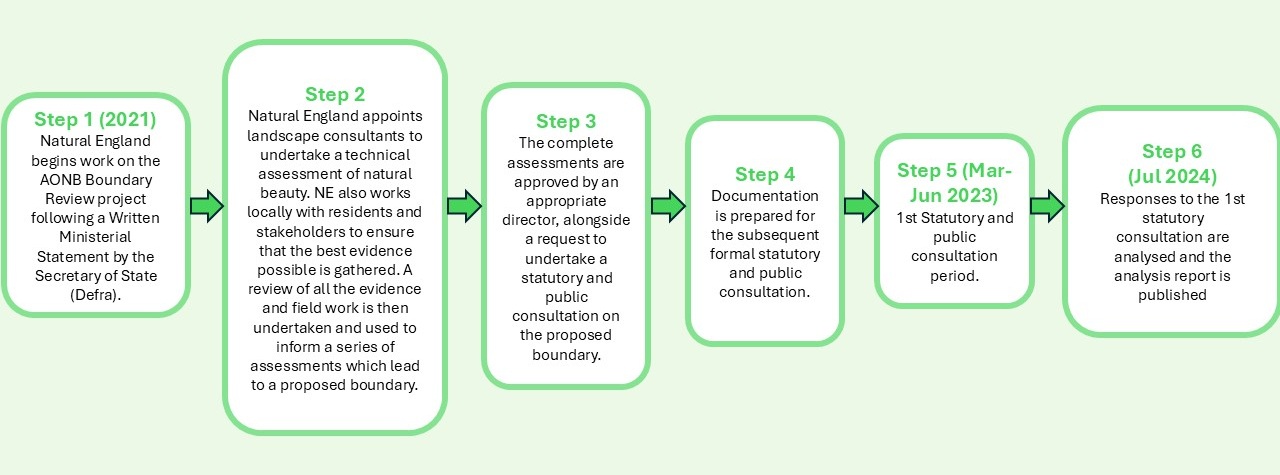Surrey Hills National Landscape (AONB) Variation Project Second Consultation
Overview
This is the webpage for the 2nd consultation for the Surrey Hills National Landscape (AONB) Boundary Variation Project, which closed on the 10th December 2024. All information and documents related to the project and consultation can be found below, including the technical reports and analysis from the 2nd consultation (dated 2024).
*AONBs were recently rebranded as National Landscapes; however, when designating, Natural England still legally designates an Area of Outstanding Natural Beauty. To avoid confusion, the reports and documents attached to this webpage refer to Areas of Outstanding Natural Beauty, or AONBs, throughout. If additional land is subsequently designated, it would then be branded as part of the Surrey Hills National Landscape.
Project Update November 2025:
On 21st November Natural England launched the notice period for the Surrey Hills National Landscape Boundary Variation. The notice period will end on 14th of January 2026.
The notice period provides an opportunity for anyone to make representations to Natural England about the proposals. All information related to the Notice Period including the Notice, the draft Order, the draft Order maps and details of how to respond can be found at https://www.gov.uk/government/publications/surrey-hills-area-of-outstanding-natural-beauty-boundary-variation
The Natural Beauty, Desirability, and Boundary Review reports for this project have been updated in order to incorporate the East Hampshire assessment information, which was previously published separately. These can be found below with the prefix 2025.
Background
Natural England is the public body responsible for conserving and enhancing the natural environment in England. One of Natural England’s statutory duties is to assess whether an area should be given special status and protection by designating it as a National Park or National Landscape. The purpose of such designation is to conserve and enhance an area’s natural beauty, and the designation is made using statutory powers in the Countryside and Rights of Way Act 2000.
In June 2021, Natural England announced a new landscape designation programme which included a review of the Surrey Hills National Landscape boundary and the consideration of a new Yorkshire Wolds designation.
The Surrey Hills National Landscape boundary has not been reviewed since its original designation in 1958 but there have been various calls locally to reconsider the boundary. Some areas of countryside outside but adjacent to the National Landscape boundary are designated as Areas of Great Landscape Value (AGLV) by local authorities in recognition of their value at a county level. Following a series of landscape evaluation studies and a formal request by the Surrey Hills National Landscape Board, Natural England began exploring whether certain areas adjacent to the Surrey Hills National Landscape should be included within the designation.
Progress so far
For a summary of progress on this project so far, please see the flow charts below.


Further information
Steps 1-4
In 2021 Natural England began work on the Surrey Hills National Landscape (AONB) Boundary Review by conducting an early call for evidence that helped build an understanding of potential areas to extend the boundary. Our specialist landscape consultants then undertook technical assessments of the landscape, identifying distinct extension areas (see steps 1 to 4 of flow chart).
Steps 5-7
In 2023 Natural England held the 1st statutory and public consultation for our proposed extension to the Surrey Hills National Landscape, receiving over 1500 responses (step 5 of the flow chart).
During our analysis work we revisited our initial assessments and undertook additional field work, especially where a review of the boundary was required. We subsequently produced a detailed analysis report which presented the findings of the consultation analysis and additional assessment of the an area East Hampshire (step 6 and 7 of the flow chart). You can find the 1st consultation analysis report and accompanying figures on the webpage for the 1st consultation Surrey Hills Area of Outstanding Natural Beauty Boundary Variation Project - Defra - Citizen Space.
Steps 8 & 9
The evidence provided through the 1st consultation process presented strong arguments to include additional land in the Surrey Hills and this was reflected in the analysis tables, accompanying figures and changes to our proposals. Following the decision to add further land to the proposal a second round of consultation was required in accordance with our duties under the Countryside and Rights of Way Act 2000.
The 2nd consultation was launched with stakeholders invited to provide a response on the changes to our proposals, including further additions, minor deletions and new land in East Hampshire (step 8 of the flow chart).
We received over 375 responses to the 2nd consultation, the vast majority of which were supportive of the proposals. During the analysis work the initial assessments were revisited and additional field work was undertaken, especially where a review of the boundary was required. The analysis report was subsequently published (step 9 of the flow chart). You can find the 2nd consultation analysis report and accompanying figures below.
Step 10
Following Natural England’s Board approval of the updated technical reports and draft Order on the 24th September 2025, the project has now been able to progress to a formal period of notice (step 10).
The Notice Period allows anyone who wishes to do so to make representations to Natural England, objecting to, supportive of, or proposing amendments to the proposal, and stating the grounds on which they are made.
Why your views matter
What happens next
Following the Notice period, representations will be analysed and any changes to the proposals will be made as required. Natural England will then proceed with preparing documentation for the making and submitting of an Order to the Secretary of State for confirmation (step 11 of the flow chart).
If there are any unresolved objections, these would be submitted to the Secretary of State with the Order.
The Secretary of State may, or may not, confirm the Order, with or without amendment. This decision is not made to any specific timescale. Any designation would not come into effect unless, and until, confirmed by the Secretary of State (step 12 of the flow chart).
Audiences
- Water/water Industry sector
- Abattoir Operator
- Aggregates sector
- Agricultural Landlords
- Agricultural Valuers
- All Defra staff and ALBs
- Angling Organisations and Trade
- Animal welfare campaigners
- Business/Private Sector
- Charities/Voluntary Organisations
- Consultants
- Consumer Groups
- Devolved Administrations
- Electrical re-use organisations
- Energy sector
- Energy suppliers
- Environmental campaigners
- Environmental Health Officers
- Environmental professional services
- Estate Agents
- Families
- Farmers
- Fishermen
- Fishing Focus individual recipients
- Food Business Operators
- Food Industry
- Government Agencies
- Government Departments
- Horse riders
- Horticulture Industry
- House Building Industry
- Households
- Industries and professional services
- Insurance industry
- Land Agents
- Landowners and their representative bodies
- Legal and Conveyancing Professions
- Leisure industry
- Licensed Gangmasters
- Livestock show ground operators
- Local Authorities
- Local Authorities
- Manufacturers of livestock identifiers
- Manufacturing Industry
- Member of the General Public
- National Park Authorities
- Non-Government Organisation
- Non-Household Customers
- Operators of animal gatherings
- Pet Carriers
- Pet Interest Groups
- Pet Owners
- Policy Teams
- Producer Compliance Schemes
- Professional and Membership Organisations/Agencies
- Property Management
- Public Bodies
- Recreation sector
- Retail Industry
- SME businesses
- Stakeholders
- Students
- Tenant Farmers
- Tourism industry
- Trading Standards Officers
- Transport Organisations
- Veterinarians
- Vets
- Walkers
- Waste Management Companies
- Waste Producers and Handlers
- Water Abstractors
- Water suppliers
Interests
- Access to countryside and coast
- Air pollution
- Air quality
- Animal diseases
- Animal welfare
- Animals
- Areas of Outstanding Natural Beauty
- Bathing waters
- Bee health
- Biodiversity
- Bycatch
- Cattle
- Chemicals and pesticides
- Climate change
- Common Agricultural Reform (CAP)
- Common land
- Conservation
- Conservation
- Construction
- Consultations
- Cross compliance
- Dairy industry
- Deforestation
- DEFRA Policy
- Disability Access
- Discarding
- Domestic Waste Water Systems
- Ecosystems services
- Egg industry
- Environmental Stewardship
- Farm management
- Flood emergency
- Flood insurance
- Flooding
- Fluorinated Greenhouse Gases
- Food and drink exports
- Food imports
- Food labelling
- Food standards
- Forestry
- Forestry
- Genetic Modification (GM)
- Green economy
- Green infrastructure
- Growing and crops
- Holiday Accommodation
- Horses
- House Building and Planning
- Hunting with dogs
- Illegal logging
- Impact Assessments
- Industry organisations representing tenant farmers and landlords
- Inland waterways
- Inland waterways
- Land management
- Livestock disease control
- Livestock identification and movement
- Local environments
- Local nature partnerships
- Marine Conservation
- Meat Industry
- National Parks
- Natural environment
- Nature reserves
- Nitrates and watercourses
- Noise
- Non-native species
- Ozone
- Pets
- Pigs
- Plants
- Policy and Delivery
- Pollution Sector
- Poultry
- Poultry industry
- Protected food names
- Protecting wildlife
- Recreational sector
- Resource Efficiency
- Retailers
- Rural broadband
- Rural Development Programme for England
- Rural economy and communities
- Rural grants and funding
- Rural Properties
- Science
- Sewerage
- Sheep and goats
- Sheep, goat and deer production/marketing
- Single Payment Scheme (SPS)
- Skills, education, training and new entrants
- Soil
- Solicitors specialising in agricultural law
- Sustainable development
- Sustainable Fishing
- Towns and village greens
- Tree and plant health
- Uplands
- Waste and recycling
- Water Abstraction
- Water Act
- Water Bill
- Water conservation
- Water Industry charging
- Water Industry licencing
- Water quality
- Watercourse maintenance
- Wildlife crime
- Wildlife management
- Wine industry

Share
Share on Twitter Share on Facebook